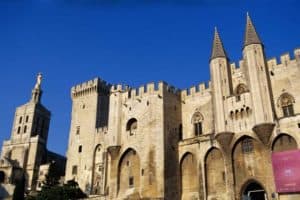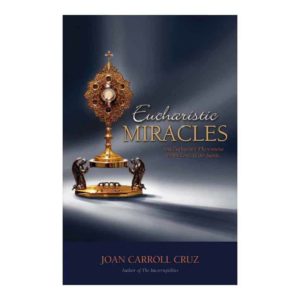Avignon, France:
Palace of the Popes and home to a Eucharistic Miracle
About Avignon:
Avignon, France is associated with one of the more interesting chapters in Catholic Church history. It was home to seven Popes from 1309 to 1378. In addition, and perhaps even more interesting, it is home to a Eucharistic Miracle that took place in the 15th Century. The town is rich in history and offers a great opportunity to sample French culture.
About the Papal Palace:

During the turbulent period of the middle ages, the popes began this magnificent building in 1335, and finished it in a mere 20 years. In 1367, Saint Catherine of Siena was sent here as an emissary of the Republic of Florence to discuss a dispute with Pope Gregory XI. Saint Catherine had been recipient of many visions and was able to persuade the Pope to return the Papacy to Rome.
September 14, 1366, Pope Urban V informed the emperor of his determination to return to Rome. All men rejoiced at the announcement except the French; the king understood that the departure from Avignon would mean a diminution of French influence at the Curia. The French cardinals were disappointed, to say the least, and even threatened to desert the pope. On 30 April, 1367, Urban left Avignon; on 19 May he sailed from Marseilles, and after a long coasting voyage he reached Corneto.
On June 4 the Romans brought the keys of Sant’ Angelo in sign of welcome, and the Gesuati (a religious order founded by Giovanni Colombini of Siena in 1360). carrying their branches in their hands and headed by their founder, Blessed John Colombini, preceded the pope. Five days later he entered Viterbo, where he dwelt in the citadel. The chaotic state of Italy made it impossible for Urban to set out to Rome until he had gathered a considerable army, so it was not till October 16 that he finally entered the city at the head of an imposing cavalcade, under the escort of the Count of Savoy, the Marquess of Ferrara, and other princes.
The palace fell into disuse over the years and ended up being used as a military barracks at one time, but the building still exists and is an interesting visit. In the Saint Martial Chapel you will see some excellent frescoes dating from this period done from 1344-46 by famous Italian (Siena school) artist Matteo Giovannetti . Matteo again put his talents to work in the Saint John Chapel in the years 1347-48 and the results are still there for everyone to admire.
Pope Benedict XII is entombed here.
It is largely empty and yet its vast space–the largest Gothic structure in Europe–recalls another era when the Popes were in residence. Today it houses an art exhibit in the summer months as well as theatrical performances during the month of July.
About the Eucharistic Miracle in Avignon:
This miracle is related to the Albigensian Heresy, which was promoted throughout Southern France. The Abligensians denied the True Presence of Christ in the Eucharist, as well as encouraging sexual promiscuity and denying the Sacraments. It was condemned by the Church in the 11th Century but managed to keep a hold on this area until well into the 13th Century.
In responding to this threat to the Eucharist, King Louis VIII (father of Saint Luis IX) built a church here to honor the Blessed Sacrament. On September 14th, 1226, Feast of the Exaltation of the Holy Cross he made a public act of reparation for the sacrilege committed by the Albigenses. A procession of the Eucharist was made to the church and the King met them as they arrived, dressed in sack cloth, a rope around his waist, and a candle in his hand,
 The Blessed Sacrament was exposed all that night and many days afterwards until the Bishop decided that the Blessed Sacrament should stay perpetually exposed. This custom was followed by his successors and approved by the Holy Father. The Church was in the care of the Grey Penitents of the Franciscan Order.
The Blessed Sacrament was exposed all that night and many days afterwards until the Bishop decided that the Blessed Sacrament should stay perpetually exposed. This custom was followed by his successors and approved by the Holy Father. The Church was in the care of the Grey Penitents of the Franciscan Order.
After about 200 years of perpetual adoration the miracle occurred: Avignon was subject to recurrent flooding, and on November 30, 1433 the flood was greater than usual, so great that it threatened not only the church floor but all the way up the altar and the monstrance where the Eucharistic was kept.
Concerned about the Eucharist in the tabernacle of the church, two of the friars had to take a boat to reach the church and were dismayed to see that the water had risen to about half way up the doors. Fearful of what they might find inside, they were shocked to discover that although the water rose up on walls on both sides of the aisle, the center was perfectly dry and the Eucharist un-touched. The friars reflected upon this as the read from the Bible to story of the parting of the Red Sea and likened it to that miracle.
Hundreds of people came to the church and witnessed the event that night. A tradition followed based on the actions the night of the flood. Each year, on November 30th in the chapel of the Church in Avignon, the Franciscan Grey Penitents tie a rope around their necks and then crawl on their hands and knees, re-creating that night in 1433.
Traveling to Avignon:
Avignon has its own airport served by some regional airlines and is easily reached by train. Note that there are two train stations serving Avignon. The TGV (high-speed) train station is about a mile from the city center and you can catch a bus from there into the train station in the city. Travel time on the TGV from Paris is about 3 1/2 hours and from Marseille about 30 minutes.
The local train from Marseille takes about 90 minutes but the beautiful countryside may be worth the extra time and the train station is in the center of town. Some TGV connections from other cities such as Paris change trains in Lyon and then proceed by local train. Get train & bus schedules, see fares & buy tickets here
Click here for the official website of the Chapel in Avignon (in French).
Photos courtesy Avignon Shrine.
⇐ Back to Catholic shrines and places of interest in France
